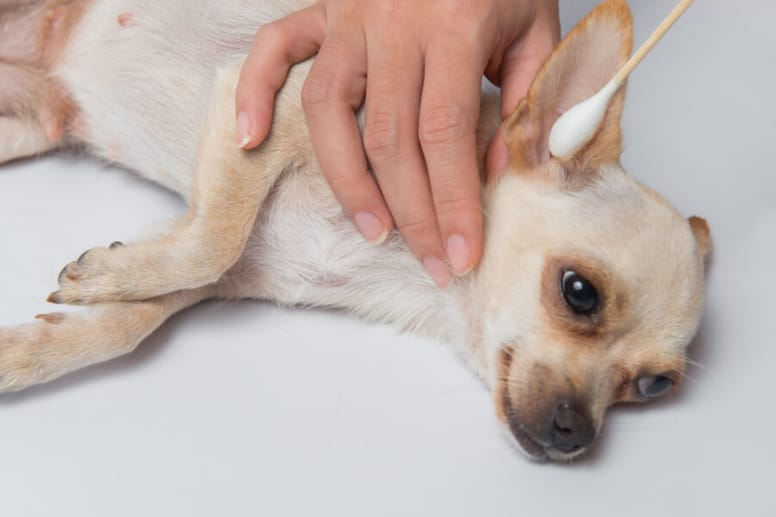Dog ear problems are not as unusual as you may have thought. According to Dr Henry Cerny: “Ear infections in dogs are common and most dogs suffer from this painful condition sometime in their life”. Therefore, if your dog starts displaying signs, that he is suffering from an ear infection, you must be there to notice it in time.
Where to start when it comes to dog ear problems?
There are three kinds of ear infections (otitis externa, media, and internal) that affect various parts of the canine ear. Furthermore, dog ear problems are more common in dog breeds with floppy ears like the Cocker Spaniel or Basset Hounds. Nonetheless, ear infections are extremely common in dogs. According to the American Kennel Club, 20% of dogs have some form of ear disease. That is why it is so important that dog owners know about the signs of dog ear problems.

Causes of dog ear problems
The most common cause of dog ear problems is bacteria in the ear canal. As you may already know, dog ear canals are mostly vertical (horizontal in human ears). Unfortunately, this makes it easier than normal for moisture to get stuck inside the ear canal. Excess moisture creates the perfect environment for bacteria to grow. However, there are other causes of dog ear problems:
- Allergies
- Ear Mites
- Fungus
- Drug reactions
- Autoimmune disease (Pemphigus)
- Endocrine disorders
- Thyroid disorders
- An excessive amount of wax
- Viruses
- Critical injury
- Over-cleaning
- Meningitis
Additionally, dog owners with pets that have excessive hair growth in their ear canal should be careful! This growth can also lead to many ear infections.
Symptoms of dog ear problems
Whenever your dog has an ear infection, he will have the following 12 signs:
- head shaking
- head tilt
- swelling
- hearing loss
- bad odours inside the ear
- scaly skin
- scratching the affected ear
- dark, smelly discharge
- redness
- itchiness
- walking in circles
- loss of balance
Diagnosing dog ear problems
If your dog is showing any of these symptoms, you have to visit your vet as soon as possible. It is important to prevent the ear infection from spreading to the middle and inner ear. Once at the vet’s office, he/she will carry out a number of tests to determine the extent and source of the infection. It would be quite helpful if you could provide information referring to:
- duration of symptoms
- dog’s eating routine
- allergies or other conditions
- any medication that you gave to your pet
- how often you clean your dog’s ears
- recent activities that your dog has done (like swimming in a pool or beach)
- history of past ear infections
Afterwards, your vet will conduct an ear examination. Sometimes, depending on your dog’s behaviour, it might require sedation. This exam usually includes:
- visual assessment of the ears to look for signs of dog ear problems
- palpation of the ear to determine the level of pain
- microscopic examination of tissue samples from the ear in question;
- examination with an otoscope;
- biopsies and X-rays.

Treatment of dog ear problems
The vet will clean your dog’s ear after he has finished the consult and he will prescribe a topical medication or systemic antibiotics. You may need to continue this treatment at home. Likewise, he can prescribe pain medication that can easu up the pain.
The important part of curing dog ear problems is the cleaning of the ear. Since you will have to do it at home, it is important that you know how to do it properly. An effective way to clean the ear is to fill the ear canal with a good cleaning solution then place a cotton ball in the ear canal opening. You could also gently massage the ear at the base. As long as your dog can handle it, you can clean the ear several times until the cotton ball comes out clean of debris.
Nonetheless, there are a few precautions when cleaning a dog’s ear. Firstly, do not use Q-Tip swabs because these can push debris deeper into the ear canal. Secondly, do not use rubbing alcohol to clean the ear as it is very irritating. Thirdly, after the ear canal has been cleaned, let it dry for approximately 10 minutes. Lastly, apply the medication(s) your veterinarian has prescribed. Don’t forget to schedule rechecks with your vet to make sure that the medicine is working.
Prevention of dog ear problems
As you can see in the video, you can start by learning how to regularly clean your dog’s ear. According to Dr Jeff Grognet, “First, fill the canal with a cleaning solution and massage the vertical ear canal from the outside. Wipe out the canal (paper towel or cotton can leave irritating fibres behind) with absorbent gauze. Don’t use paper towels or cotton because these may leave fibres behind, and those could cause an irritation. Cotton-tipped sticks may be useful in cleaning the folds on your dog’s ear flap, but don’t use them in the ear canal. You might inadvertently push debris deeper into the canal and pack it at the bottom”.
Also, trim any excess hair in the outer ear canal with special grooming scissors. If you don’t know how to do it, go to the groomer.
Lastly, remember that dog ear problems can be quite serious. Make sure to treat them with the respect that they deserve.

